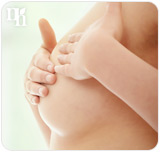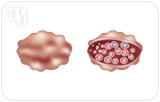Menopause is instigated by hormones, chemicals messengers in the body that move throughout the bloodstream. The hormones estrogen, progesterone, and testosterone are responsible for numerous changes in the female reproductive system. They are fundamental in the transitions that take place during puberty, pregnancy, lactation, and menopause.

Women may experience unpleasant physical and emotional symptoms during menopause. These symptoms, which include hot flashes, night sweats, loss of libido, fatigue, headaches, and mood swings, are a manifestation of hormonal activity in the body. During times of hormonal fluctuations, the body experiences an imbalance and symptoms arise.
There are many different hormonal and non-hormonal ways to treat the symptoms of menopause. Continue reading to learn more about estrogen replacement therapy (ERT) and phytoestrogens, two treatments that can be used to address menopausal hormonal imbalance, and combat the undesirable symptoms of menopause.
Estrogen Replacement Therapy
ERT, is a hormonal method of combating the symptoms of menopause. It entails introducing external estrogen into the body by injection, pill, vaginal ring, or patch. The additional estrogen in the body supplements the body's natural estrogen supply, balances hormone levels, and prevents the onset of menopause symptoms.
There are numerous advantages and disadvantages associated with ERT. Compare the following lists to determine if this treatment is right for you.
Advantages of Estrogen Replacement Therapy
- Decreased risk of osteoporosis
- Decreased risk of bowel cancer
- Decrease in LDL ("bad" cholesterol) and increase in HDL ("good" cholesterol)
- Decreased risk of colorectal cancer
Disadvantages of Estrogen Replacement Therapy

- Breast tenderness
- Water retention
- Weight gain
- Nausea
- Headaches
- Heavy periods
HRT can also increase the risk of:
- Breast cancer
- Ovarian cancer
- Strokes
- Blood clots
- Deep vein thrombosis
Phytoestrogens
Phytoestrogens are substances found in certain plants that have estrogen-like properties. When ingested into the body, phytoestrogens act like estrogen, and supplement low estrogen levels, avoiding the full impact of menopause symptoms. They are considered to be an herbal alternative to ERT as they both increase estrogen levels in the body.
The most common phytoestrogenic herbs are:

- Black cohosh
- Ginseng
- Soy
- Red clover
- Dong quai
There is a host of treatments that can be used to combat menopause symptoms caused by estrogen and other hormones. To find out more, and for further information about increasing estrogen levels, click here.


